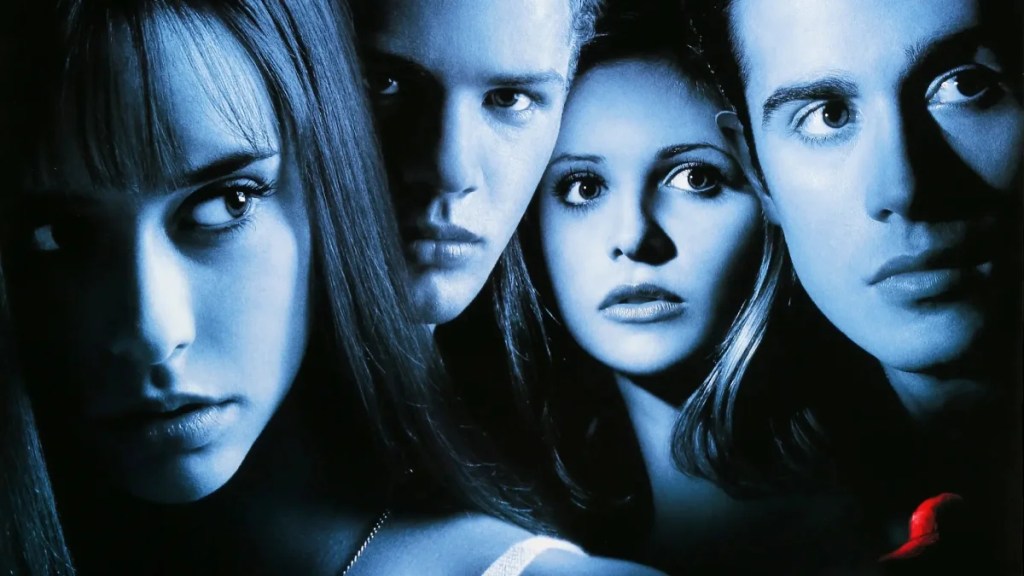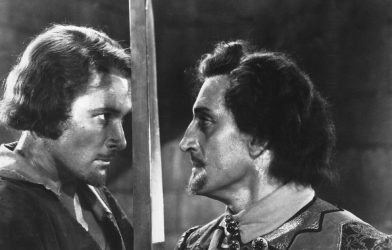A couple weeks ago I completely blew somebody’s mind. We were talking about popular zombie movies and I mentioned that before Danny Boyle’s “28 Days Later” was an unexpected hit in 2002, the zombie genre was considered, ironically, kinda dead. Sure, we got a zombie movie every once in a while, but outside of the hardcore horror fanbase, the walking dead wasn’t a concept most people cared about or took very seriously. It just goes to show you: One hit film really can revive a whole genre, and for generations to come.
The same holds true for slasher movies. After John Carpenter’s “Halloween” defined the genre in 1978 — it’s a stretch to say Carpenter “invented it” but he certainly codified the easy-to-copy, very successful formula — slashers became a dominant force in horror cinema for over a decade. They were cheap to produce, so big studios and independents could compete on a relatively level playing field. And they had a built-in audience of horror hounds and mainstream fans looking for shrieky thrills, so they were (almost) always profitable.
More from TheWrap
So Hollywood did what they always do when they have a winning formula for success: They overexploited it and ran it into the ground. By the early 1990s, after over ten years of ubiquity, slasher movies were played out. When Wes Craven decided to stick a pin in the whole genre with “Scream,” a self-aware teen slasher about why slasher movies don’t work anymore, it seemed like it was going to be the official end of the era.
And then “Scream” was so damn good — and so damned profitable — that it brought slasher movies entirely back to life. The late 1990s and early 2000s were rife with movies either riffing on “Scream” or shamelessly capitalizing on its success. These post-“Scream” slashers typically applied irony and/or nostalgia to the slasher formula, and although not all of them were smart or skillful enough to get away with it, in retrospect many of them were stylish, interesting horror movies. Even though many mainstream films critics, as is still the case today, didn’t understand what made them work, the fans really were on to something.
The post-“Scream” slasher movies are fascinating snapshots of the horror industry at the turn of the century. Most of them are fun. Some of them are genuinely great. These are the best.
Honorable Mention: ‘Wishmaster’ (1997)

Andew Divoff and Robert Englund in ‘Wishmaster’ (Live Entertainment)
Robert Kurtzman’s fiendishly clever ‘Wishmaster’ was one of the first films to capitalize on the breakout success of ‘Scream’ — they certainly were proud to announce that it was produced by Wes Craven — but it’s more like the last gasp of the pre-‘Scream’ slasher genre than a step in the direction of the new one. The gravelly-voiced Andrew Divoff stars as the title villain, an ancient Djinn who kills by granting wishes as ironically as possible. A wish for eternal beauty turns one woman into a mannequin, a security says the only way into a building is “through him” and that goes about as well as you can expect. “Wishmaster” is packed with cameos from horror luminaries like Robert Englund, Tony Todd and Reggie Bannister, and it spawned one wickedly fun sequel (“Evil Never Dies”) followed by two cheap, disappointing follow-ups. But even those stinkers have interesting ideas.
‘I Know What You Did Last Summer’ (1997)

Freddie Prinze Jr. and Jennifer Love-Hewitt in ‘I Know What You Did Last Summer’ (Columbia Pictures)
‘Scream’ is one of the rare blockbusters that turned its screenwriter into a superstar. Kevin Williamson’s smart, self-aware, character-driven screenplay was such a game-changer that one of his old scripts got immediately dusted off and rushed into production. This adaptation of Lois Duncan’s popular YA thriller novel, “I Know What You Did Last Summer” stars Jennifer Love-Hewitt, Freddie Prinze Jr., Sarah Michelle Gellar and Ryan Phillippe as teens who accidentally run a stranger over and make a vow to never to tell anyone, only to be stalked and murdered a year later. Williamson’s script didn’t please Lois Duncan, who objected to his violent take on the material, but faithful or not, he cleverly weaved Duncan’s Hitchcockian thriller into the realm of campfire stories, transforming its villain into a modern version of the Hookman. The first two sequels were junk, the TV series was weirdly convoluted and enjoyable, and the legacy sequel is a hoot and a half.
‘Halloween H20: 20 Years Later’ (1998)

Jamie Lee Curtis in ‘Halloween: H20’ (Dimension Films)
The revived slasher genre didn’t just spawn new films for a new generation of teens, it also gave studios an excuse to resurrect their once-profitable name brand franchises. “Halloween H20″’” is one of the most successful examples, retconning all but the first two movies out of continuity, and bringing Jamie Lee Curtis back as Laurie Strode. She’s spent 20 years in witness protection and struggles with PTSD and alcoholism, and is understandably overprotective of her teenage son (Josh Hartnett), who sneaks out on Halloween to canoodle with his girlfriend (Michelle Williams). Naturally, Michael Meyers attacks. In many ways “H20” is an old-fashioned, efficient slasher but Curtis’s textured, powerful performance is arguably her best in the series, and the film’s ending is a stunning reversal that turns the hunted into the hunter. It would have been a great ending to the series if “Halloween: Resurrection” hadn’t rewritten and ruined it four years later. (Way to go, Hollywood. Once again you learned nothing.)
‘Urban Legend’ (1998)

??? and Natasha Greggson-Wagner in ‘Urban Legend’ (TriStar Pictures)
Jamie Blanks’ runaway hit “Urban Legend” has great ideas for kills but, in the wrong kind of twist, subpar execution. The students at a prestigious university — played by Alicia Witt, Rebecca Gayheart, Joshua Jackson, Jared Leto and Danielle Harris — are getting murdered by a serial killer obsessed with turning urban legends into reality. So there’s a killer in the backseat of a victim’s car, an ankle gets slashed by a murderer underneath another car, and even the old “Pop Rocks and Soda” gag gets pulled out of the woodwork. The movie never comes up with a great reason why the killer is so anal about these recreations, and it’s amusingly implausible that they (almost) always go according to plan, but the game cast and exuberant presentation make up for those flaws. Mostly. There were sequels, and they’re not all bad, but the original is the one that makes an impression.
‘Bride of Chucky’ (1998)

Brad Dourif and Jennifer Tilly in ‘Bride of Chucky’ (Universal Pictures)
In retrospect, “Scream” might have been the best thing that ever happened to the “Child’s Play” series. Don Mancini’s classic creation, about a serial killer trapped in the body of a popular kids toy, was always riding the edge of camp. So when the screenwriter had an excuse to go totally meta and unapologetically camp, he dove in headfirst and completely changed the direction and tone of the series. “Bride of Chucky” introduces Jennifer Tilly as the titular bride, and Brad Dourif finally gets to go completely, demonically comical as the titular groom. They tag along on a road trip with Katherine Heigl and Nick Stabile, framing the young couple for their murderers, and wreaking all kinds of havoc. Directed by Ronny Yu, with a beautiful eye and a madcap energy, “Bride of Chucky” planted the seed (get it?) for the genre-and-gender-bending future installments, letting this series expand into the inventive and ambitious directions that make it popular to this very day.
‘Cherry Falls’ (1999)

Brittany Murphy and Keram Malicki-Sánchez in ‘Cherry Falls’ (USA Films)
Geoffrey Wright’s “Cherry Falls” turns the whole slasher concept on its head by reversing one of its alleged “rules.” In most slashers, the people who have sex get killed. In “Cherry Falls” the serial killer exclusively targets virgins, inspiring the whole high school student body to stage a wild orgy to get themselves off the chopping block. The late Brittany Murphy stars alongside Gabriel Mann, Jesse Bradford, Michael Biehn and Jay Mohr, in a film where there’s a weird sexual energy between every pair of characters, whether it makes sense or it’s creepy as hell. “Cherry Falls” is thrilling and funny while also tackling some very serious, harrowing topics. Sensitive viewers may want to look into the film’s content before deciding if it’s for you, but if you can handle the weird alchemy of subversive humor and grim, grim darkness, “Cherry Falls” is one of the best post-“Scream” slashers.
‘Final Destination’ (2000)

Devon Sawa in ‘Final Destination’ (New Line Cinema)
The post-“Scream” slasher wave started to mutate with “Final Destination,” an exhilarating experiment in removing the killer from the genre while keeping all the kills. Devon Sawa and Ali Larter lead a cast of teens who narrowly escape a horrifying airline disaster, but the living embodiment of Death still needs them to die, so it manipulates the world around them to arrange a series of elaborate, shocking “accidents” that get the job done. “Final Destination” is an exercise in pure cinema, where the thrills emerge from simply willing them into existence, warping reality into Rube Goldberg machines of death and mayhem. The film inspired a long-running franchise, and most of them are as good as the original or even better, but the first “Final Destination” laid the groundwork for all that followed.
‘Valentine’ (2001)

??? in ‘Valentine’ (Warner Bros. Pictures)
Jamie Blanks returned to the slasher genre with the critically reviled box office disappointment “Valentine,” a film which actually kinda rules. Denise Richards, Marley Shelton, Jessica Capshaw, Jessica Cauffiel and Katherine Heigl star as childhood friends who are stalked by an obsessive murderer who they humiliated back in grade school. David Boreanaz co-stars, and the film’s disappointing financial returns effectively killed his movie career, but the cast is excellent and the screenplay — which constantly highlights how men treat women like prey, whether they’re literally murderers or not — is smart and cutting. “Valentine” is overdue for rediscovery and reappraisal, and it makes a great double feature with the excellent 2025 horror-comedy “Heart Eyes.”
‘Jason X’ (2001)

Kane Hodder, Melyssa Ade, Derwin Jordan and Lexa Doig in ‘Jason X’ (New Line Cinema)
The “Friday the 13th” series was doing meta humor years before it was fashionable, with the high-energy sixth entry, “Jason Lives,” transforming the villain into a supernatural horror monster and having clever fun with all the clichés. Ever since, Jason Voorhees had been getting into one strange-ass situation after another, fighting psychics and vacationing in Manhattan and swapping bodies and getting into kinky BDSM shaving. (Yes, really.) By the time he went to outer space in “Jason X” it actually made more sense than usual. Scientists, led by David Cronenberg (!), abduct the undead Jason to study his inhuman healing factor, but the monster gets frozen for hundreds of years and wakes up on a spaceship filled with horny teens, super soldiers a la “Aliens,” sexy androids and hologram simulations that know all his tricks. Very funny, very entertaining stuff. If you can get past the fact that you can’t possibly take it seriously, “Jason X” is one of the all-time great “Friday the 13th” sequels.
‘Behind the Mask: The Rise of Leslie Vernon’ (2006)

Nathan Baesal and Angela Goethals in ‘Behind the Mask: The Rise of Leslie Vernon’ (Anchor Bay Entertainment)
Where does the post-“Scream” slasher wave actually end? Probably around the same time that “Saw” ushered in the “torture porn” genre. But a few stragglers came out afterwards. There’s a convincing argument to be made that Scott Glosserman’s “Behind the Mask: The Rise of Leslie Vernon” was the last gasp of the post-“Scream” era, and it’s one hell of a last hurrah. Nathan Baesal plays a slasher villain who agrees to let a documentary film crew record his day-to-day activities, revealing all the complex planning that goes into fake out jump scares, as well as the tedious-but-necessary tasks like replacing all the batteries in everybody’s flashlights with ones that are almost dead. A riff on the classic French mockumentary “Man Bites Dog,” Glosserman’s film makes light of our familiarity with the genre’s tropes before getting its head on straight and reminding us all that slashers are, fundamentally, still disturbing.
The post The 9 Best Post-‘Scream’ Slasher Movies appeared first on TheWrap.









